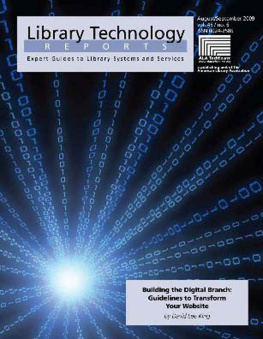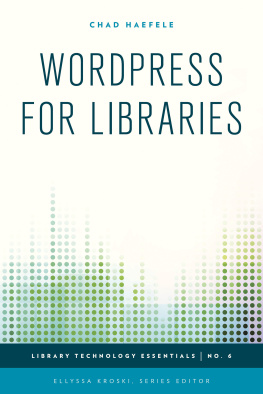

Library Technology Reports
ALA TechSource purchases fund advocacy, awareness, and accreditation programs for library professionals worldwide.
Volume 50, Number 6
Digital Media Labs in Libraries
ISBNs: (print) 978-0-8389-5934-3; (PDF) 978-0-8389-5935-0; (ePub) 978-0-8389-5936-7; (Kindle) 978-0-8389-5937-4.
American Library Association
50 East Huron St.
Chicago, IL 60611-2795 USA
alatechsource.org
800-545-2433, ext. 4299
312-944-6780
312-280-5275 (fax)
Advertising Representative
Patrick Hogan
312-280-3240
Editor
Patrick Hogan
312-280-3240
Copy Editor
Judith Lauber
Production and Design
Tim Clifford, Production Editor
Karen Sheets de Gracia, Manager of Design and Composition
Library Technology Reports (ISSN 0024-2586) is published eight times a year (January, March, April, June, July, September, October, and December) by American Library Association, 50 E. Huron St., Chicago, IL 60611. It is managed by ALA TechSource, a unit of the publishing department of ALA. Periodical postage paid at Chicago, Illinois, and at additional mailing offices. POSTMASTER: Send address changes to Library Technology Reports, 50 E. Huron St., Chicago, IL 60611.
Trademarked names appear in the text of this journal. Rather than identify or insert a trademark symbol at the appearance of each name, the authors and the American Library Association state that the names are used for editorial purposes exclusively, to the ultimate benefit of the owners of the trademarks. There is absolutely no intention of infringement on the rights of the trademark owners.

alatechsource.org
Copyright 2014 Amanda L. Goodman
All Rights Reserved.
Amanda L. Goodman is the user experience (UX) librarian at Darien Library, a public library in Connecticut. In this position, she planned, implemented, and manages a busy digital media lab. She wrote the book The Comparative Guide to WordPress in Libraries: A LITA Guide and has written articles for UX Magazine and Library Journal. Now she cohosts a podcast about UX and libraries called #libux, which can be found at http://libux.co. Find her on Twitter as @godaisies.
Abstract
A digital media lab is a gathering of equipment with which people create digital content or convert content that is in analog formats. In this report Amanda L. Goodman profiles digital media libraries selected according to the following criteria: they provide equipment to the community for the creation of video, audio, or other digital content; they offer resources to transform analog media (e.g., cassette tapes, records, etc.) to digital formats; and they offer digital literacy programs to help people learn how to create digital content. People are creating content, not just consuming it. From the perspective of library spaces, Goodman advises on equipment, software, training, and policies. She also profiles digital media lab projects in five libraries.
Get Your Library Technology Reports Online!
Subscribers to ALA TechSources Library Technology Reports can read digital versions, in PDF and HTML formats, through the scholarly content host MetaPress. Subscribers also have access to an archive of past issues. Visit alatechsource.metapress.com to begin reading. Beside each issue title you will see a solid green box indicating that it is available to you. You may need to log in to be recognized by the system. Please contact MetaPress Support, support@metapress.com, if you have any questions about or problems with access.
Subscriptions
alatechsource.org/subscribe
Contents
Abstract
Chapter 1 of Library Technology Reports (vol. 50, no. 6) Digital Media Labs in Libraries makes the case that digital media labs fit squarely into the librarys role in education and in providing public spaces. The chapter lists funding sources and defines scope by describing the setup in libraries of various sizes and resource levels.
T he Great Recession of the 2000s was hard. Each week across the United States, the news was full of stories of library funding being cut and libraries shutting down. Yet it was during this onset of bad news that a revolution was called for within libraries. This movement would change library patrons from consumers of information to creators. Phil Shapiro of PC World wrote in 2010, You start using the library space as a collaborative space to make things: books, music CDs, instructional videotapes, screencasts, art, inventions, software, and so on. Some libraries were ahead of the curve and had added creation spaces many years prior to the Great Recession. One version of this drive for content-creation space in a library is called a digital media lab (DML). This report explores what goes into building a digital creation center.
A DML is a gathering of equipment that allows original digital content to be created or analog content to be converted to digital formats. Sometimes a DML is a separate room in a library; other times its a cart bearing the equipment. Oftentimes, there is a staff and time investment in teaching patrons how to use the equipment. A DML is found not only in libraries, but also in museums and in academic departments for new media students and future journalists.
In this report, the DMLs selected may not all be considered DMLs by the libraries that house them, but each was chosen by the author because it fits several of the following criteria:
It provides equipment to the community for the creation of video, audio, or other digital content.
It offers members of the community the ability to transform analog media (e.g., cassette tapes, records, etc.) to digital formats.
It offers digital literacy programs on how to create digital content.
Content is being created in some form rather than just consumed.
A library that offers only a scanner would not be considered as having a DML, but a library that provides audiovisual equipment and a space to use that equipment would be.
Not every DML in this report may be part of a library, but it may provide you with ideas about where to look for funding or how much a DML may cost or other creative ideas to borrow.
A Rose by Any Other Name
DMLs go by many names. Tracking down a wide variety of labs for this report was hindered somewhat because so many name variations exist. The most common terms include creative, creation, and digital. All libraries mentioned in this report are in the United States but this does not mean that other countries lack outstanding examples of DMLs.
What Is a Makerspace?
A makerspace can include elements of a DML. However, makerspaces focus on the production of physical objects. Makerspaces had their origins in the hackerspace movements, but for libraries, the term makerspace tends to be more patron-friendly because it does not have the negative connotations of the word hacker. Makerspaces may also involve health hazards, such as the use of power tools, while it is unlikely that someone would get hurt taking photos or digitizing audio.
Hybrid DMLs
Not all content created in a DML is necessarily digital. Sometimes digital creations are printed out either as 2-D objects such as photos or as 3-D prints. The inclusion of 3-D printers, which create physical objects, causes some overlap between a DML and a makerspace. However, because such 3-D objects start out as digital files, I am including in this report DMLs that offer 3-D printers. These DMLs may be considered hybrids because they straddle the line between digital and physical creation. One example of this type of creative space is Chattanooga Public Librarys 4th Floor. While the library does not call the 4th Floor a makerspace or DML, it has elements of bothas well as its own flavor because the space is open and constantly changing.















